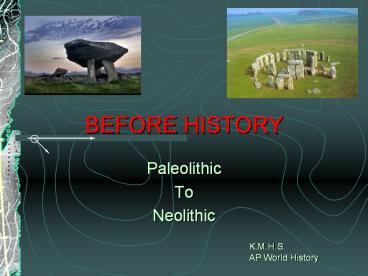BEFORE HISTORY - PowerPoint PPT Presentation
1 / 36
Title: BEFORE HISTORY
1
BEFORE HISTORY
- Paleolithic
- To
- Neolithic
K.M.H.S. AP World History
2
ESSENTIAL QUESTIONS
- What are the origins and migration patterns of
human beings? - How is human environmental interaction a factor
in the Neolithic Revolution? - How do you define or distinguish civilization?
- How did development of sedentary agriculture
affect gender roles? - How do economic systems impact political systems?
3
CONCEPTS TERMS
- Paleolithic
- Mesolithic
- Paleontology
- Hunter-gatherers
- Bands
- Pastoralists
- Nomadic lifestyle
- Diffusion cultural, religious, etc.
- Neolithic
- Archeology
- Sedentary agriculture / Intensive agriculture
- Patriarchy / Matriarchy
- Matrilocal / Patrilocal
- Complex society
- Urbanization
- Syncretization
- Civilization
4
Time Line Prehistory B.C.E.
- 2.5 M gt Hominin
- 1 M gt Homo Erectus
- 120 K gt Homo Sapiens
- 30 K gt Americas
- 15 K gt Domestic Dogs
- 8500 6500 gt Domestication
- farm animals
- 8500 gt Neolithic agriculture.
- 7000 gt Jericho
- 3000 gt Catal-Huyuk
5
TIME LINE
6
HUMAN ORIGINS
- Out of Africa
- Mitochondria DNA evidence
- Australopithecus
- Southern Ape
- Hominid 4M to 1M years ago
- Hominid gt hominin
- Human lineage
- Homo Erectus
- Upright walking man
- Migrated to Asia and Europe 1.5M to 200K y.a.
7
MIGRATION PATTERNS
8
HOMO ERECTUS
9
PALEOLITHIC
- Homo Sapiens
- thinking man
- Neanderthalensis 100K 35K y.a.
- Ritual burials
- Cro-Magnon Homo Sapiens Sapiens
- Modern humans cave paintings
- Venus figurines quasi religion
- Hunter-gatherers
- Men/hunters, women/gatherers
- Stone, wood, bone tools, animal hide clothes,
jewelry
10
PALEOLITHIC MESOLITHIC
- HUNTER GATHERERS
- Social Structure
- Small family groups or bands
- Gender Equity
- Relatively equal because of the important role of
women - Males hunters
- Females gatherers
11
HOMO SAPIENS
- Cro-Magnon
- Neanderthal
12
NEANDERTHAL SITES
Neanderthals Eastern Hemisphere
13
CRO-MAGNON SITES
?
14
Lascaux
15
NEOLITHIC New Stone Age 12K to 6K
y.a.
- Emergence of Agriculture10K to 8K
- Slash burn frequent migration
- Subsistence agriculture
- Impact of Agriculture on gender
- Women originated but heavy labor and
defense of surplus was taken over by men - Change from Venus fertility religion to
polytheistic male dominant religions
Venus of Wilendorf
16
SPREAD OF AGRICULTUREMay reference Guns,
Germs, Steel
17
TIME FRAMES CROPS ANIMALS BCE
- Southwest Asia c. 9000
- Wheat barley
- Goats, cattle, sheep, pigs
- Africa c.7000 West Africa
- West Africa
- Sorghum yams
18
TIME FRAMES CROPS ANIMALS BCE
- Southeast Asia c. 3500
- Yams and citrus fruits
- China
- Yangtze c. 6500
- Rice
- Huang He c. 5500
- Soybeans, pigs, chickens
19
TIME FRAMES CROPS ANIMALS BCE
- Americas 4000 - 3000
- Mexico
- Maize, beans, squash, tomatoes, peppers
- Andean
- Potatoes maize
20
BENEFITS OF AGRICULTURE
21
CIVILIZATION / COMPLEX SOCIETY
- Sedentary agricultural lifestyle
- Production of large agricultural surplus
- Government to protect surplus
- Development of ELITES who control surplus
- THEY DO NOT LABOR
22
CIVILIZATION / COMPLEX SOCIETY
- SPECIALIZATION OF LABOR
- Innovations in technology, etc.
- Technological advancements
- Craft workers to produce goods
- Merchants to trade goods
23
SOCIETAL RELATIONSHIPS
24
Legal Systems
Government Military
Gender Roles
Social Strata
Sedentary life style
Metallurgy Technology
Ruling Elite
Division Of Labor
AGRIULTURE
Religion
Trade Networks
Science
Urbanization
Writing system
Disease Pathogens
Mathematics
Economic Surplus
Slavery
25
AGRARIAN REVOLUTIONS
- They were not concurrent
26
AGRARIAN REVOLUTION
- Food Surplus
- Population explosion
- Neolithic Towns
- Jericho defensive walls
- Catal-Huyuk
- In Anatolia 8K inhabitants
- Largest known city 32 acres
- SPECIALIZATION OF LABOR
- POTTERY, METALLURGY TIN BRONZE, TEXTILE
PRODUCTION
27
BRONZE AGE 4 K 1500 BCE
- Technological innovation
- Metallurgy
- Moved societies from using stone implements
28
SOCIAL DIFFERENTIATION
- Emergence of social classes.
- Based upon political and economic power
- Control of agricultural surplus
- Kings, aristocracy priests
- Utilize slave or labor debt to work govt.
controlled fields. - Specialization of labor
- Workforce of skilled artisans emerge
29
CATAL HUYUK JERICHO
- Largest known urban center 8 K
-
Defensive walls
30
Fertile Crescent
No Geographic Barriers
Geographic Barriers
31
IMPACT ON SOCIETY
- POLITICAL
- Urbanization
- Cities were large
- Emergence of Complex Societies
- Impacted stratification
- Political, economic, cultural influence
- SOCIAL STRATIFICATION
- Emergence of social classes
- Based upon private ownership or control of land
thus agricultural surplus
32
IMPACT ON SOCIETY
- RELIGION
- Celebrated deities associated with life-cycle
- Emergence of priest class
- Priest class supported ruler
- Both control surplus
- EARLIEST CITIES
- Mesopotamia
- Between Tigris Euphrates Rivers
- 4K 3K B.C.E.
33
EVOLUTION OF RELIGION
- Tigris Euphrates
- Harsh environmental conditions
- Frequent devastating floods
- Vengeful punishing gods emerge
- Nile Valley
- Beneficial predictable flooding
- Bountiful agriculture
- Peaceful benign gods emerge
34
ANCIENT GODS
- Baal gt Master
- Vengeful
- Pantheon gt Natural forces
35
RIVER VALLEY
LEBANON PHOENICIA
SYRIA
IRAQ
ISRAEL
36
ENDURING QUESTIONS
- May reference Ishmael
- Has the impact of civilization been beneficial or
detrimental over the ages? - What are the benefits and detriments of
sedentary agriculture as opposed to nomadic
lifestyles? - Why did civilized society refer to outlanders
as barbarians or savages? - Examine the Greek word xenophobe and identify
how it relates to the previous question.































